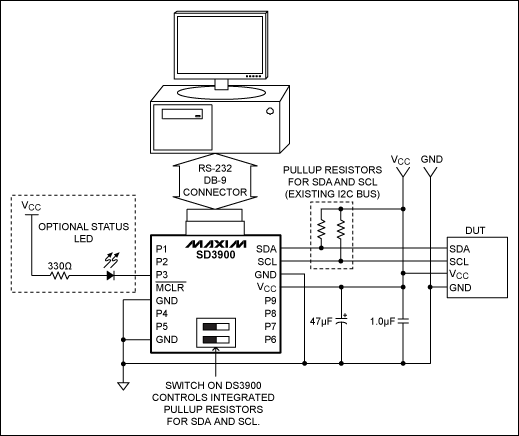
Use a DS3900 to Evaluate I²C-CompaTIble Devices for Successful BidirecTIonal CommunicaTIon
Abstract: This applicaTIon note explains the design considerations and hardware requirements for developing a hardware solution to establish I²C-compatible communications using a DS3900.
The DS3900 is used to evaluate I²C-compatible components, and it provides fast, bidirectional communication with 2-wire devices using a PC's serial port. Figure 1 shows the recommended configuration for establishing communications between a DS3900 and an I²C-compatible device. An example of a breakout board for the DS3900 is shown in Figure 2. This small, efficient PCB (printed circuit board) provides everything necessary for I²C communications with the DS3900, and it allows the user to quickly interface with I²C-compatible devices.
Figure 1. Typical DS3900 interface schematic.
Figure 2. Example DS3900 interface board.
There are several notable aspects of the interface which users need to understand. All optional and critical functions of the circuit are detailed below.
The DS3900 can use either the on-board pullup resistors for SDA (Serial DatA) and SCL (Serial CLock), or the resistors already employed in an existing application. The switch² in Figure 1 controls whether or not the DS3900's on-board resistors are used for the pullup to VCC. In short, if the DS3900 is to be used on an I²C bus that already has pullup resistors, use the switch to disconnect the DS3900's on-board pullup resistors. SDA and SCL can then be attached safely to the target board or component.
The DS3900 has a number of convenient features. P3 is an open-collector I/O that can be used to drive a status LED. The connection in Figure 1 is made through VCC, which will affect power-supply currents when the LED is turned on. There are several other I/O pins available on the DS3900; their functions are defined in the DS3900 data sheet.
The communications with the DS3900 are handled by either the DS3900 EV Kit or the I²C-specific software included with the Maxim device being evaluated. If no device-specific software exists, the DS3900 EV kit software will be more than sufficient. The DS3900 connects to a PC through the RS-232 port. The evaluation software kits available on the FTP site are all executables with intuitive user interfaces.
Things to remember:
- Use the same supply for the DS3900 and the DUT if at all possible. Use additional decoupling in applications sensitive to supply and GND noise.
- Make sure that the SDA and SCL pullup resistors are used either on the DS3900 or on the target board.
- MAKE SURE THAT ALL THREE (3) GND PINS OF THE DS3900 ARE GROUNDED AND CONNECTED TO THE GND REFERENCE OF THE TARGET BOARD.
If the preceding recommendations are followed, it will be easy to use the DS3900 to evaluate I²C-compatible devices.
Notes
¹Digikey® offers the 47µF capacitor used for DS3900 evaluation of analog signals. Here the AVX® PN# is used. Any equivalent capacitor will suffice.
²The DPDT (dual position, double throw) DIP switch on DS3900 controls pullup resistors.
AVX is a registered trademark of AVX Corporation.
Digi-Key is a registered trademark of Digi-Key Corporation.
欢迎分享,转载请注明来源:内存溢出

 微信扫一扫
微信扫一扫
 支付宝扫一扫
支付宝扫一扫
评论列表(0条)